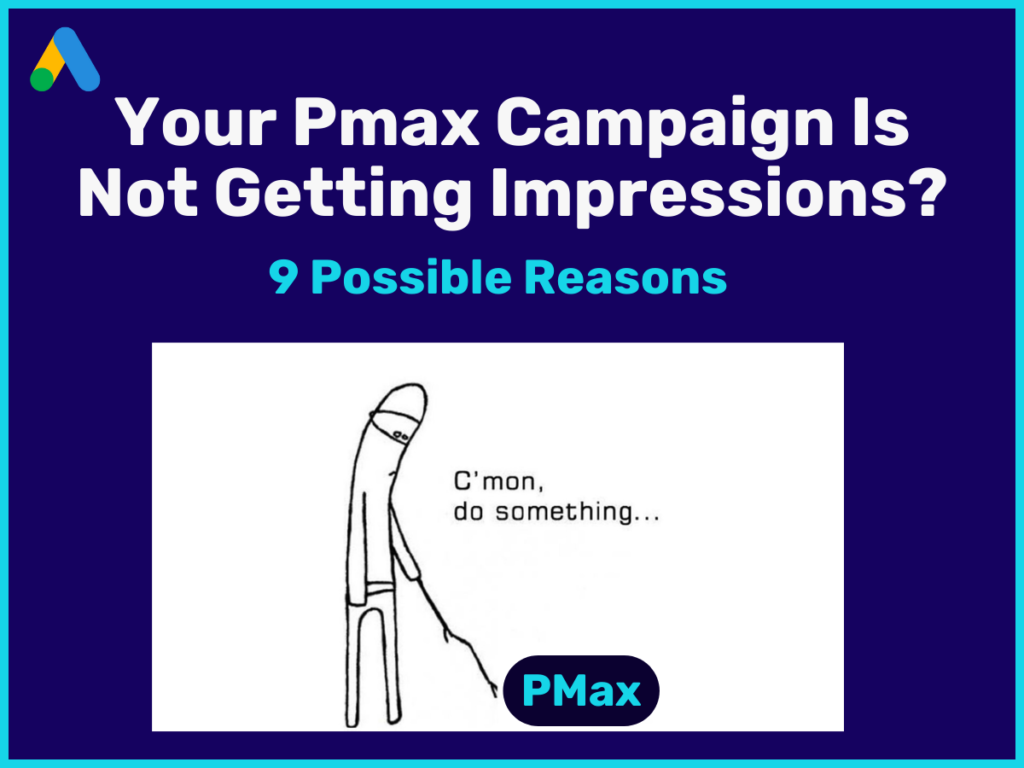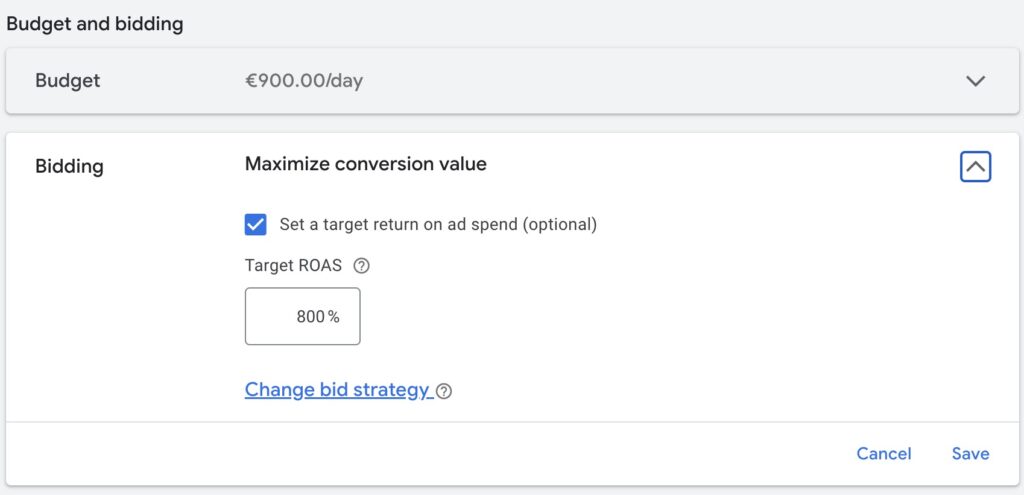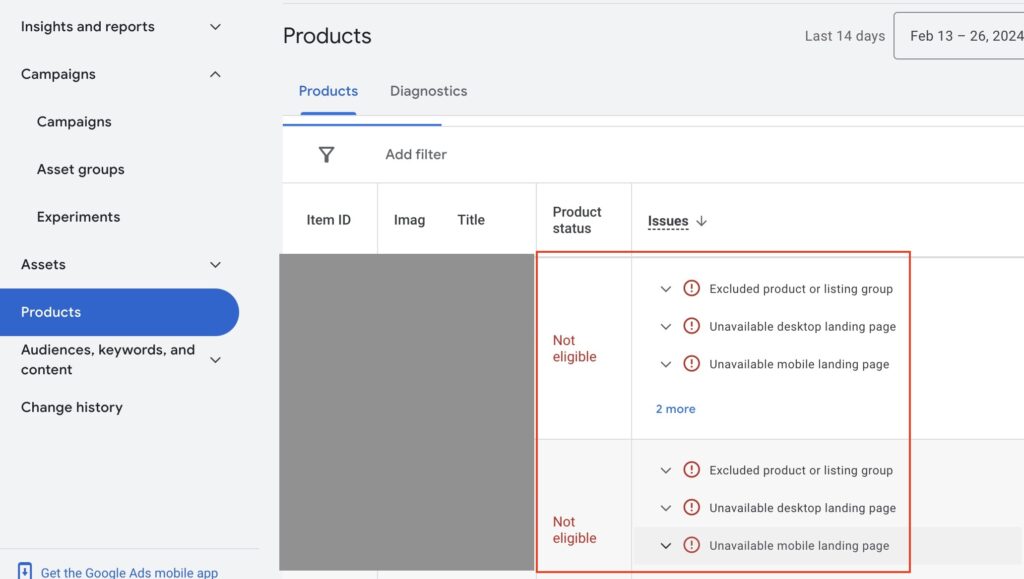von Thimo Hofner

Your Performance Max (PMax) campaign has no or only a few impressions? This can be frustrating. Especially since Google gives you little insight into what is actually happening. But don’t worry! You’re not the first one with this problem.
In this post, you’ll find the most common reasons for low impressions in Performance Max campaigns. I will also show you possible solutions to make your campaign work as desired.
Here is an overview of the 9 reasons
For each of these reasons, you will find a detailed explanation of what you should investigate.
Ready? Let’s go!
By the way, if you want you can also check out my Video on this:
First of all, you should make sure that there are no overarching problems with your account. It may be that Google is blocking your account due to violations and therefore none of your ads are being displayed.
Reasons could be, for example, problems with payment or violations of the Google guidelines in the ads.
First of all, therefore, check whether there is such a problem. It is worth taking a look at the notifications within Google Ads:

If this is a brand new campaign in your case, the reason for the lack of impressions is most likely Google’s review process. Google itself explains that it can take up to 48 hours for new PMax ads to be reviewed and approved:

But even after these 2 days, your campaign may still appear somewhat limited. This is because the start of a new campaign also marks the beginning of the learning phase for the Google algorithm, which is supposed to determine which target groups, keywords, etc. lead to the best performance.
It can take up to 6 weeks until the algorithm has collected enough data and can exploit its full potential. Until then, it is always possible that the impressions are somewhat limited.
You can find out more here: Performance Max learning phase.
Major campaign changes can also cause the algorithm to start a new learning phase and reduce the number of impressions.
Budget
Bidding strategy
Language and region
URLs or placements
Brand exclusions
Pausing or adding new asset groups
If you have made recent changes, in most cases, impressions will return to normal after 1-2 weeks.
Ideally, you should have already made all settings at the start of a campaign. It is best not to change anything in the first 4 weeks.
Avoid making too many changes – especially to the budget or bidding strategy. Make sure that the adjustments are always a maximum of 20% at a time.
After each change, you should give the algorithm time to process the changes and adjust the campaign accordingly. Therefore, avoid weekly changes.
Have you just created your Google Ads account? In this case, Google may only spend your budget cautiously at first. It is also possible that your campaign will not be displayed at all in the first 2-3 days.
Google is particularly careful with new accounts.
So if this is the case for you, wait another 3 days. If the problem persists, the reason for the unused budget may be one of the others in this post.
With PMax campaigns, you have 2 options for the bidding strategy: Maximize Conversions or Maximize Conversion Value.
Depending on your choice, the Google algorithm will either focus on optimizing the number of conversions (such as leads or sales) or on maximizing revenue.
In addition, you can define a target CPA (cost per action = cost per conversion) to maximize conversions or a target ROAS (ROAS = return on ad spend) to maximize conversion value.
This allows you to further restrict and control the bidding strategy.

However, if the defined target ROAS or target CPA is too aggressive, this can lead to the algorithm having difficulties generating enough conversions. As a result, it will reduce the impressions because it cannot achieve the targets under any circumstances.
Target ROAS: A target ROAS that is too high means that you want to achieve a high return on ad spend, possibly to ensure that your ad spend is profitable.
Target CPA: Similarly, a low target CPA requires that you want to minimize the cost per conversion to advertise more efficiently.
While these goals are generally reasonable, a target ROAS or target CPA that is too restrictive can limit your campaign.
The target restrictions for the bidding strategies are very powerful tools if you use them correctly. However, if used, they can also have an extremely negative impact on your campaign.
Therefore, here are the most important things you should keep in mind:
Start without a target CPA or target ROAS: Even though Google recommends it, experience has shown that it is best to start without a target. This allows the algorithm to learn without restrictions and perhaps even perform better than your original goal.
Use realistic and not dream goals: Always base your ROAS or CPA goals on current performance and not on your target values.
Avoid too large and too frequent changes: The bidding strategy is one of the most important signals for the Google algorithm. A change to this basically is a readjustment of the entire campaign. The algorithm may therefore start a new learning phase.
To avoid this:
Only small (max. 20%) changes at longer intervals (3-4 weeks)

It can happen that Google does not show any ads or only shows limited ads because there are problems with the texts, images, videos or landing pages that you have added in the asset groups.
If Google determines that some of your assets violate guidelines, this will restrict your entire campaign.
Typical policy violations can be the following:
Trademark law
Landing page does not exist => 404 errors
Use of unauthorized characters or formatting
If there are policy violations in your asset groups, you can recognize this by looking at the status of each asset group.
For each policy violation, Google will give you information on what you need to do to fix the violation. In most cases, these are minor adjustments to the ad texts or images.
Google automatically checks your assets for policy violations. It is therefore more common for Google to point out violations even though there is no problem with your assets.
In this case, you can appeal against the decision. The issue will then be checked manually.
Even if PMax campaigns often seem somewhat intangible, in the end, it is still about showing appealing ads to the right people at the right time. To do this, the Google algorithm needs strong and sufficient ad assets.
If the quality and/or number of your assets is not sufficient, the effectiveness of your ads will suffer. Google also notices this. And if your ads don’t click well, one of your competitors will be displayed. Here is the information from Google.
Therefore, always make sure to include enough headlines and descriptions, images and videos and attach importance to high quality.
Tip: You can use the asset details to see the performance of the individual assets and recognize how well your texts, images and videos work.
You can find out more here: Evaluate PMax asset performance
One reason for the limited delivery of a campaign can also be that there are one or more other campaigns with the same targeting. The targeting can mean the audience, the keywords or even the region.
With this overlap, the different campaigns compete in the same auctions.
The traffic is then either split between the two campaigns, which can restrict both campaigns or one campaign is favored. It can then happen that the other campaign cannot generate any impressions at all.
PMax competes with other PMax
In this case, it is not clear what will happen. What is certain, however, is that you want to avoid this scenario at all costs. The only exception here are catch-all PMax campaigns in ecommerce. These serve as a supplement and promote all products.
Otherwise, make sure you don’t overlap products and campaign topics while targeting the same region.
PMax competes with search campaigns
Google prefers Performance Max over search campaigns in most cases. However, search campaigns are preferred for exact match keywords.
It is still usually beneficial to supplement your PMax campaign with search campaigns as they give you more insight and control.
PMax competes with Shopping campaigns
If a PMax and a Shopping campaign contain the same products, the ads of the PMax campaign will be displayed preferentially. Nevertheless, the Shopping campaign may receive some impressions and thus limit the delivery of the PMax campaign.
It can still be useful to use PMax and Shopping campaigns – just without any overlap. You can find out more about the difference between PMax and Shopping campaigns here.
If you running an e-commerce campaign with a product feed, problems with your products can also lead to your campaign being restricted and only generating a few impressions.
In most cases, PMax with a product feed focuses primarily on Shopping ads. However, these only work with an intact product feed and eligible products.
If there are problems with the products, the Google algorithm can only display Shopping ads to a limited extent or not at all. This change can result in the campaign only receiving a few impressions.
Use the product reports in Google Ads or go directly to the product diagnostics in the Google Merchant Center. Check whether your feed is working and whether there are status messages for products.

Common problems :
Sold-out products: If a product is no longer available, it will of course no longer be advertised. Especially if the products are bestsellers, this can have a major impact on your entire campaign.
Rejected products: If products are rejected in the Google Merchant Center, they are no longer available for promotion. Therefore, check your rejected products regularly.
Restricted products: Products with missing or incomplete information are restricted in the application process. Google uses the information, such as the product title or description, to control the Shopping ads.
If these are not sufficient, Google will rarely display the products and your budget may not be utilized.
Unreachable target URL: The URLs of your products in the feed may be no longer up-to-date. In this case, they can no longer be advertised.
Intact conversion tracking is essential for the success of your Performance Max campaigns.
Because with the 2 available bidding strategies maximize conversions and maximize conversion value, conversions are the goal towards which the algorithm optimizes.
If there are problems with tracking (e.g. purchases are no longer transmitted), the algorithm lacks the success signal. This means that if it can no longer achieve any conversions, the campaign is limited and will no longer be served or only very rarely.
To check your conversions, you should navigate to the overview of your conversions or target projects.
If there are problems with a conversion, this will be visible in the status column. If the status is not set to active no conversions have been coming in recently.

If this is the case, you should investigate the implementation of conversion tracking.
If you have set up the conversion with Google Tag Manager (GTM) or Google Analytics, you can test it in the preview mode of GTM.
Do you need help? I can help you with conversion tracking.
Another reason for a low number of impressions can be a small target audience. While you don’t really limit your audience in PMax campaigns with the audience signals, the location settings are a precise audience targeting control.
So the reason your impressions are unusually low may be that you are focusing on a too small area where there are not enough people for which your ads are relevant.
If possible, you should expand your target region in this case. If this is not possible in your case, it may well be that your campaign is already operating at its limit and simply cannot generate any more impressions.
Last but not least, I would like to talk about some trivial reasons that are surprisingly often the problem. The good thing is that they are easy to fix. Could your lack of impressions be due to one of the following reasons?
Campaign is not activated
Asset groups are not activated
Campaign has a start or end date that prevents it from being displayed
I hope this post has helped you to find the reason why your PMax campaigns have few or no impressions.
There can be many reasons for this, from a too narrow target audience to technical problems to peculiarities of the Google algorithm.
If you still haven’t found your reason, you could contact the Google support. Especially when it comes to getting your campaigns up and running and spending money, they will be happy to help 😉
Thanks for reading and good luck with your campaigns!
Work smart – Clicks in Mind

Hi, my name is Thimo Hofner. I have been working in online marketing as a Google Ads Manager for more than 5 years. Through many courses, trainings and most importantly working with many different clients, I have learned the best strategies for success with Google Ads. On my blog and YouTube, I share my knowledge to help you drive more success with online marketing.